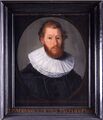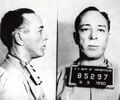Template:Selected anniversaries/December 9: Difference between revisions
No edit summary |
No edit summary |
||
| (21 intermediate revisions by the same user not shown) | |||
| Line 1: | Line 1: | ||
<gallery> | <gallery> | ||
|| *** DONE: Pics *** | |||
||1048: Al-Biruni dies ... mathematician. Pic (stamp). | ||1048: Al-Biruni dies ... mathematician. Pic (stamp). | ||
File:Reinerus Frisius Gemma, by Maarten van Heemskerck.jpg|link=Gemma Frisius (nonfiction)|1508: Physician, mathematician, and cartographer [[Gemma Frisius (nonfiction)|Gemma Frisius]] born. He will create important globes, improve the mathematical instruments of his day, and apply mathematics to surveying and navigation in new ways. | |||
File: | File:Adriaan Metius.jpg|link=Adriaan Metius (nonfiction)|1571: Mathematician and astronomer [[Adriaan Metius (nonfiction)|Adriaan Metius]] born. He will manufacture precision astronomical instruments, and publish treatises on the astrolabe and on surveying. | ||
||1667: William Whiston born ... mathematician, historian, and theologian. Pic. | ||1667: William Whiston born ... mathematician, historian, and theologian. Pic. | ||
| Line 14: | Line 14: | ||
||1742: Carl Wilhelm Scheele born ... pharmaceutical chemist. He made a number of chemical discoveries before others who are generally given the credit. For example, Scheele discovered oxygen (although Joseph Priestley published his findings first), and identified molybdenum, tungsten, barium, hydrogen, and chlorine before Humphry Davy, among others. Pic. | ||1742: Carl Wilhelm Scheele born ... pharmaceutical chemist. He made a number of chemical discoveries before others who are generally given the credit. For example, Scheele discovered oxygen (although Joseph Priestley published his findings first), and identified molybdenum, tungsten, barium, hydrogen, and chlorine before Humphry Davy, among others. Pic. | ||
||1748: Claude Louis Berthollet born ... chemist and academic ... became vice president of the French Senate in 1804. He is known for his scientific contributions to theory of chemical equilibria via the mechanism of reverse chemical reactions, and for his contribution to modern chemical nomenclature. | ||1748: Claude Louis Berthollet born ... chemist and academic ... became vice president of the French Senate in 1804. He is known for his scientific contributions to theory of chemical equilibria via the mechanism of reverse chemical reactions, and for his contribution to modern chemical nomenclature. Pic. | ||
||1752: Antoine Étienne de Tousard born ... general and engineer. | ||1752: Antoine Étienne de Tousard born ... general and engineer. No pics online. | ||
||1779: Tabitha Babbitt born ... tool maker and inventor. Pics online unreliable, consult library. | ||1779: Tabitha Babbitt born ... tool maker and inventor. Pics online unreliable, consult library. | ||
||1793: New York City's first daily newspaper, the American Minerva, is established by Noah Webster. | ||1793: New York City's first daily newspaper, the American Minerva, is established by Noah Webster. Pic. | ||
||1813: Thomas Andrews born ... chemist and physicist. Pic. | ||1813: Thomas Andrews born ... chemist and physicist. Pic. | ||
| Line 34: | Line 34: | ||
||1867: Johann Nicolaus von Dreyse born ... firearms inventor and manufacturer. He is most famous for submitting the Dreyse needle gun in 1836 to the Prussian army. Pic. | ||1867: Johann Nicolaus von Dreyse born ... firearms inventor and manufacturer. He is most famous for submitting the Dreyse needle gun in 1836 to the Prussian army. Pic. | ||
File:LED Traffic Light.jpg|link=Traffic light (nonfiction)|1868: The first [[Traffic light (nonfiction)|traffic lights]] are installed, outside the Palace of Westminster in London. Resembling railway signals, they use semaphore arms and are illuminated at night by red and green gas lamps. | |File:LED Traffic Light.jpg|link=Traffic light (nonfiction)|1868: The first [[Traffic light (nonfiction)|traffic lights]] are installed, outside the Palace of Westminster in London. Resembling railway signals, they use semaphore arms and are illuminated at night by red and green gas lamps. | ||
File:Fritz Haber.png|link=Fritz Haber (nonfiction)|1868: Chemist [[Fritz Haber (nonfiction)|Fritz Haber]] born. He will receive the Nobel Prize in Chemistry in 1918 for his invention of the Haber–Bosch process, a method used in industry to synthesize ammonia from nitrogen gas and hydrogen gas. | File:Fritz Haber.png|link=Fritz Haber (nonfiction)|1868: Chemist [[Fritz Haber (nonfiction)|Fritz Haber]] born. He will receive the Nobel Prize in Chemistry in 1918 for his invention of the Haber–Bosch process, a method used in industry to synthesize ammonia from nitrogen gas and hydrogen gas. Haber will also do pioneering work in chemical warfare, weaponizing chlorine and other poisonous gases during World War I. | ||
||1881: Carl Culmann dies ... structural engineer. Pic. | ||1881: Carl Culmann dies ... structural engineer. Pic. | ||
File:Nikolai Luzin stamp.jpg|link=Nikolai Luzin (nonfiction)|1883: Mathematician, theorist, and academic [[Nikolai Luzin (nonfiction)|Nikolai Luzin]] born. He will contribute to descriptive set theory and aspects of mathematical analysis with strong connections to point-set topology. | File:Nikolai Luzin stamp.jpg|link=Nikolai Luzin (nonfiction)|1883: Mathematician, theorist, and academic [[Nikolai Luzin (nonfiction)|Nikolai Luzin]] born. He will contribute to descriptive set theory and aspects of mathematical analysis with strong connections to point-set topology. | ||
||1886: Clarence Birdseye born ... inventor, entrepreneur, and naturalist, and is considered to be the founder of the modern frozen food industry. Pic. | |||
||1897: Activist Marguerite Durand founds the feminist daily newspaper ''La Fronde'' in Paris. Pic. | ||1897: Activist Marguerite Durand founds the feminist daily newspaper ''La Fronde'' in Paris. Pic. | ||
||1898: Emmett Kelly born ... American clown and actor. Pic. | ||1898: Emmett Kelly born ... American clown and actor. Pic. | ||
||1902: Hans Wilhelm Eduard Schwerdtfeger born ... mathematician who worked in Galois theory, matrix theory, theory of groups and their geometries, and complex analysis. Pic. | ||1902: Hans Wilhelm Eduard Schwerdtfeger born ... mathematician who worked in Galois theory, matrix theory, theory of groups and their geometries, and complex analysis. Pic. | ||
File:Dalton Trumbo prison 1950.jpg|link=Dalton Trumbo (nonfiction)|1905: Screenwriter and novelist [[Dalton Trumbo (nonfiction)|Dalton Trumbo]] born. | File:Dalton Trumbo prison 1950.jpg|link=Dalton Trumbo (nonfiction)|1905: Screenwriter and novelist [[Dalton Trumbo (nonfiction)|Dalton Trumbo]] born. He will be blacklisted for refusing testify before the House Un-American Activities Committee (HUAC) in 1947; while blacklisted, he will win Academy Awards for two films: ''Roman Holiday'', attributed to a front author, and ''The Brave One'' under the pseudonym Robert Rich. | ||
||1905: Emanuel Sperner born ... mathematician. He proposed Sperner's theorem, which says that the size of an antichain in the power set of an n-set (a Sperner family) is at most the middle binomial coefficient(s). Pic. | ||1905: Emanuel Sperner born ... mathematician. He proposed Sperner's theorem, which says that the size of an antichain in the power set of an n-set (a Sperner family) is at most the middle binomial coefficient(s). Pic. | ||
| Line 56: | Line 56: | ||
||1905: Herbert Fröhlich born ... physicist. Fröhlich proposed a theory of coherent excitations in biological systems known as Fröhlich coherence. A system that attains this state of coherence is known as a Fröhlich condensate. Pic. | ||1905: Herbert Fröhlich born ... physicist. Fröhlich proposed a theory of coherent excitations in biological systems known as Fröhlich coherence. A system that attains this state of coherence is known as a Fröhlich condensate. Pic. | ||
||1906: Grace Hopper born . | File:Commodore Grace M. Hopper, USN.jpg|link=Grace Hopper (nonfiction)|1906: Computer scientist and Admiral [[Grace Hopper (nonfiction)|Grace Hopper]] born. She will pioneer computer programming techniques, inventing one of the first compilers, and popularizing machine-independent programming languages (leading to the development of COBOL). | ||
||1907: Max Deuring born ... mathematician. He is known for his work in arithmetic geometry, in particular on elliptic curves in characteristic p. He worked also in analytic number theory. Pic. | ||1907: Max Deuring born ... mathematician. He is known for his work in arithmetic geometry, in particular on elliptic curves in characteristic p. He worked also in analytic number theory. Pic. | ||
| Line 65: | Line 65: | ||
||1917: James Rainwater born ... physicist and academic, Nobel Prize laureate. Pic. | ||1917: James Rainwater born ... physicist and academic, Nobel Prize laureate. Pic. | ||
||1919: William Lipscomb born ... chemist and academic, Nobel Prize laureate. Pic. | ||1919: William Lipscomb born ... chemist and academic, Nobel Prize laureate. Pic. | ||
| Line 90: | Line 88: | ||
||1965: ''A Charlie Brown Christmas'', first in a series of Peanuts television specials, debuts on CBS. | ||1965: ''A Charlie Brown Christmas'', first in a series of Peanuts television specials, debuts on CBS. | ||
||1968: Enoch L. Johnson | ||1968: Enoch L. Johnson born ... Atlantic City, New Jersey political boss, Sheriff of Atlantic County, New Jersey, businessman, and racketeer. He was the undisputed "boss" of the political machine that controlled Atlantic City and the Atlantic County government from the 1910s until his conviction and imprisonment in 1941. His rule encompassed the Roaring Twenties when Atlantic City was at the height of its popularity as a refuge from Prohibition. In addition to bootlegging, his organization was also involved in gambling and prostitution. Pic. | ||
||1968: Douglas Engelbart gave what became known as "The Mother of All Demos", publicly debuting the computer mouse, hypertext, and the bit-mapped graphical user interface using the oN-Line System (NLS). Pic. | ||1968: Douglas Engelbart gave what became known as "The Mother of All Demos", publicly debuting the computer mouse, hypertext, and the bit-mapped graphical user interface using the oN-Line System (NLS). Pic. | ||
| Line 104: | Line 102: | ||
||2009: Jack Kenneth Hale dies ... mathematician working primarily in the field of dynamical systems and functional differential equations. Pic: http://math.gatech.edu/hg/item/589462 | ||2009: Jack Kenneth Hale dies ... mathematician working primarily in the field of dynamical systems and functional differential equations. Pic: http://math.gatech.edu/hg/item/589462 | ||
||2012: Norman Joseph Woodland dies ... inventor, co-created the bar code. | ||2012: Norman Joseph Woodland dies ... inventor, co-created the bar code. Pic. | ||
||2012: Patrick Moore dies ... astronomer and television host. Pic. | |||
||2014: Marc Yor dies ... mathematician well known for his work on stochastic processes, especially properties of semimartingales, Brownian motion and other Lévy processes, the Bessel processes, and their applications to mathematical finance. Pic. | ||2014: Marc Yor dies ... mathematician well known for his work on stochastic processes, especially properties of semimartingales, Brownian motion and other Lévy processes, the Bessel processes, and their applications to mathematical finance. Pic. | ||
||2015: Norman Breslow dies ... statistician and academic. | ||2015: Norman Breslow dies ... statistician and academic. Pic. | ||
</gallery> | </gallery> | ||
Latest revision as of 17:09, 7 February 2022
1508: Physician, mathematician, and cartographer Gemma Frisius born. He will create important globes, improve the mathematical instruments of his day, and apply mathematics to surveying and navigation in new ways.
1571: Mathematician and astronomer Adriaan Metius born. He will manufacture precision astronomical instruments, and publish treatises on the astrolabe and on surveying.
1718: Monk, cosmographer, and cartographer Vincenzo Coronelli dies. He gained fame for his atlases and globes; some of the globes are very large and highly detailed.
1814: Physician Golding Bird born. He will pioneer the medical use of electricity.
1868: Chemist Fritz Haber born. He will receive the Nobel Prize in Chemistry in 1918 for his invention of the Haber–Bosch process, a method used in industry to synthesize ammonia from nitrogen gas and hydrogen gas. Haber will also do pioneering work in chemical warfare, weaponizing chlorine and other poisonous gases during World War I.
1883: Mathematician, theorist, and academic Nikolai Luzin born. He will contribute to descriptive set theory and aspects of mathematical analysis with strong connections to point-set topology.
1905: Screenwriter and novelist Dalton Trumbo born. He will be blacklisted for refusing testify before the House Un-American Activities Committee (HUAC) in 1947; while blacklisted, he will win Academy Awards for two films: Roman Holiday, attributed to a front author, and The Brave One under the pseudonym Robert Rich.
1906: Computer scientist and Admiral Grace Hopper born. She will pioneer computer programming techniques, inventing one of the first compilers, and popularizing machine-independent programming languages (leading to the development of COBOL).







